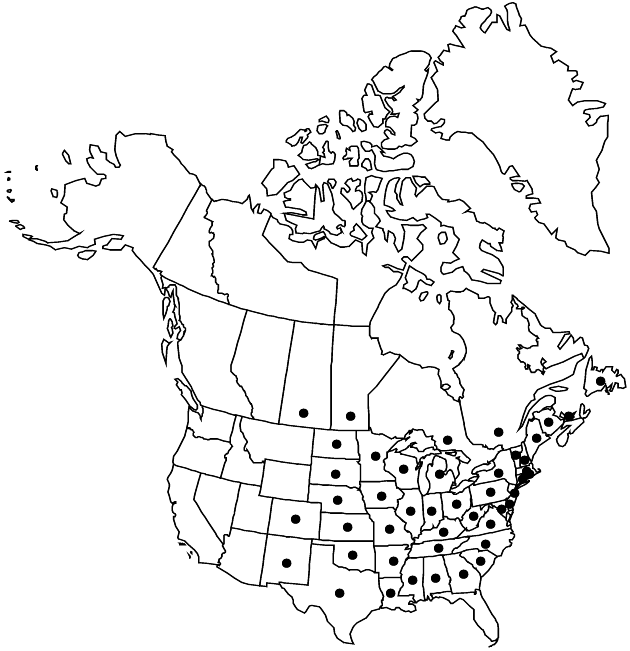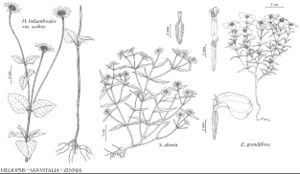Difference between revisions of "Heliopsis helianthoides"
Hort. Brit., 487. 1826.
FNA>Volume Importer |
RevisionBot (talk | contribs) m (Bot: Adding category Revised Since Print) |
||
| (7 intermediate revisions by 3 users not shown) | |||
| Line 8: | Line 8: | ||
}} | }} | ||
|common_names=False sunflower;oxeye;smooth oxeye;héliopside faux-hélianthe | |common_names=False sunflower;oxeye;smooth oxeye;héliopside faux-hélianthe | ||
| − | |basionyms={{Treatment/ID/ | + | |special_status={{Treatment/ID/Special_status |
| + | |code=F | ||
| + | |label=Illustrated | ||
| + | }}{{Treatment/ID/Special_status | ||
| + | |code=E | ||
| + | |label=Endemic | ||
| + | }} | ||
| + | |basionyms={{Treatment/ID/Basionym | ||
|name=Buphthalmum helianthoides | |name=Buphthalmum helianthoides | ||
|authority=Linnaeus | |authority=Linnaeus | ||
| + | |rank=species | ||
| + | |publication_title=Sp. Pl. | ||
| + | |publication_place=2: 904. 1753 | ||
}} | }} | ||
|synonyms= | |synonyms= | ||
| Line 23: | Line 33: | ||
-->{{Treatment/Body | -->{{Treatment/Body | ||
| − | |distribution= | + | |distribution=Man.;N.B.;Nfld. and Labr. (Nfld.);Ont.;Que.;Sask.;Ala.;Ark.;Colo.;Conn.;Del.;Ga.;Ill.;Ind.;Iowa;Kans.;Ky.;La.;Maine;Mass.;Md.;Mich.;Minn.;Miss.;Mo.;N.C.;N.Dak.;N.H.;N.J.;N.Mex.;N.Y.;Nebr.;Ohio;Okla.;Pa.;R.I.;S.C.;S.Dak.;Tenn.;Tex.;Va.;Vt.;W.Va.;Wis. |
|discussion=<p>Varieties 2 (2 in the flora).</p><!-- | |discussion=<p>Varieties 2 (2 in the flora).</p><!-- | ||
--><p>As T. R. Fisher (1957) noted, intermediates occur between <i></i>var.<i> helianthoides</i> and <i></i>var.<i> scabra</i>, and artificial hybrids show only slightly decreased pollen stainabilities and normal meiotic pairing. Intermediates are especially common in Missouri, Illinois, and New England, and may also be encountered elsewhere in areas of sympatry. In addition to the key characters, <i></i>var.<i> helianthoides</i> generally has longer petioles, has smaller heads on shorter peduncles, and occupies less-open habitats than <i></i>var.<i> scabra</i>.</p> | --><p>As T. R. Fisher (1957) noted, intermediates occur between <i></i>var.<i> helianthoides</i> and <i></i>var.<i> scabra</i>, and artificial hybrids show only slightly decreased pollen stainabilities and normal meiotic pairing. Intermediates are especially common in Missouri, Illinois, and New England, and may also be encountered elsewhere in areas of sympatry. In addition to the key characters, <i></i>var.<i> helianthoides</i> generally has longer petioles, has smaller heads on shorter peduncles, and occupies less-open habitats than <i></i>var.<i> scabra</i>.</p> | ||
| Line 48: | Line 58: | ||
-->{{#Taxon: | -->{{#Taxon: | ||
name=Heliopsis helianthoides | name=Heliopsis helianthoides | ||
| − | |||
|authority=(Linnaeus) Sweet | |authority=(Linnaeus) Sweet | ||
|rank=species | |rank=species | ||
| Line 55: | Line 64: | ||
|basionyms=Buphthalmum helianthoides | |basionyms=Buphthalmum helianthoides | ||
|family=Asteraceae | |family=Asteraceae | ||
| − | |distribution= | + | |distribution=Man.;N.B.;Nfld. and Labr. (Nfld.);Ont.;Que.;Sask.;Ala.;Ark.;Colo.;Conn.;Del.;Ga.;Ill.;Ind.;Iowa;Kans.;Ky.;La.;Maine;Mass.;Md.;Mich.;Minn.;Miss.;Mo.;N.C.;N.Dak.;N.H.;N.J.;N.Mex.;N.Y.;Nebr.;Ohio;Okla.;Pa.;R.I.;S.C.;S.Dak.;Tenn.;Tex.;Va.;Vt.;W.Va.;Wis. |
|reference=None | |reference=None | ||
|publication title=Hort. Brit., | |publication title=Hort. Brit., | ||
|publication year=1826 | |publication year=1826 | ||
| − | |special status= | + | |special status=Illustrated;Endemic |
| − | |source xml=https:// | + | |source xml=https://bitbucket.org/aafc-mbb/fna-data-curation/src/2e0870ddd59836b60bcf96646a41e87ea5a5943a/coarse_grained_fna_xml/V19-20-21/V21_147.xml |
|tribe=Asteraceae tribe Heliantheae | |tribe=Asteraceae tribe Heliantheae | ||
|subtribe=Asteraceae (tribe Heliantheae) subtribe Ecliptinae | |subtribe=Asteraceae (tribe Heliantheae) subtribe Ecliptinae | ||
| Line 67: | Line 76: | ||
}}<!-- | }}<!-- | ||
| − | -->[[Category:Treatment]][[Category:Heliopsis]] | + | --> |
| + | |||
| + | [[Category:Treatment]] | ||
| + | [[Category:Heliopsis]] | ||
| + | [[Category:Revised Since Print]] | ||
Latest revision as of 18:24, 6 November 2020
Perennials, (40–)80–150 cm. Aerial stems (from creeping rhizomes to 4 cm × 2–6 mm, rhizome internodes mostly 2–10 mm) 1–10+, stramineous to reddish brown, glabrous or hairy. Leaf blades ovate to deltate-lanceolate, 6–12(–15) × 2–6(–12) cm, margins regularly to irregularly and coarsely dentate, apices acute to acuminate, faces glabrous, sparsely pubescent, moderately to densely scabrellous, or scabrous. Heads 1–15+. Peduncles 9–25 cm. Involucres 12–25 mm diam. Phyllaries glabrescent to densely pubescent on margins, apices, and abaxial faces. Paleae lanceolate to oblong, apices obtuse, faces glabrous. Ray florets 10–18; corollas golden yellow, laminae mostly 2–4 cm × 6–13 mm. Disc florets 10–75+; corollas yellowish to brownish yellow (lobes brighter than tubes), 4–5 mm, glabrous. Cypselae 4–5 mm, glabrous or pubescent on angles, smooth; pappi 0 or of 2–4 minute, toothlike scales. 2n = 28 (variety unknown).
Distribution

Man., N.B., Nfld. and Labr. (Nfld.), Ont., Que., Sask., Ala., Ark., Colo., Conn., Del., Ga., Ill., Ind., Iowa, Kans., Ky., La., Maine, Mass., Md., Mich., Minn., Miss., Mo., N.C., N.Dak., N.H., N.J., N.Mex., N.Y., Nebr., Ohio, Okla., Pa., R.I., S.C., S.Dak., Tenn., Tex., Va., Vt., W.Va., Wis.
Discussion
Varieties 2 (2 in the flora).
As T. R. Fisher (1957) noted, intermediates occur between var. helianthoides and var. scabra, and artificial hybrids show only slightly decreased pollen stainabilities and normal meiotic pairing. Intermediates are especially common in Missouri, Illinois, and New England, and may also be encountered elsewhere in areas of sympatry. In addition to the key characters, var. helianthoides generally has longer petioles, has smaller heads on shorter peduncles, and occupies less-open habitats than var. scabra.
Selected References
None.
Key
| 1 | Leaf blades ovate, 8–12(–15) × 4–8(–12) cm, abaxial faces glabrous or sparsely pubescent, adaxial faces glabrous or minutely scabrellous | Heliopsis helianthoides var. helianthoides |
| 1 | Leaf blades deltate to narrowly ovate-lanceolate, 6–12 × 2–5 cm, faces moderately to densely scabrellous to scabrous | Heliopsis helianthoides var. scabra |
